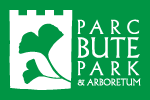Fisher’s Bridge, Bute Park
Fisher’s Bridge, Bute Park
Press play for RNIB audio presentation
Or, download mp3 (1.63MB)
A 1772 mortgage document mentions Fisher’s Bridge – referring not to a bridge but a field! As you stand on the current bridge and look south (towards Cardiff Castle), left of the water you’ll see the £22.5m theatre and concert hall opened by the Royal Welsh College of Music and Drama in 2011. It stands on what was once the Fisher’s Bridge field.

Male demoiselle damselfly. Photo by Barbara Brown
That document also tells us a “former tucking mill was erected” on this land. The tucking or fulling mill – where woollen fabric was soaked in urine and beaten to soften the fibres and improve the cloth’s quality – was in use by c.1314. It is called Newmyll in a document from 1492 which also mentions a fishery between Newmyll and the corn mills near Cardiff town. So we get a picture of a bridge used by fishers across the mill leat. When the fulling mill was demolished, some time after 1715, the cleared land was identified as the field near Fisher’s Bridge.
The watercourse below the bridge was once the mill stream (a channel for the water that powered the mill wheels). It was incorporated into the dock feeder canal from 1836 to 1844. The second Marquess of Bute had decided to create an ambitious new dock near the mouth of the Taff, with locks to ensure the water was high enough for ships to arrive or depart at all tides. A lot of water was flushed away each time the lock was emptied, so a system to replenish the dock water was needed. The feeder canal tapped the flow of the Taff at Blackweir at a higher elevation than the dock water’s surface, and gravity kept the docks supplied.
The feeder is still in use today – any blockage could affect commercial operations at the docks. If you don’t recall seeing this water flowing through the city centre, that’s because it’s largely hidden from view along the back of Queen Street and then underground from behind the New Theatre and to south of the city centre.

Giant rhubarb in Bute Park. Photo by Barbara Brown
To continue our Bute Park tour, take the path along the canal’s right-hand side. This path was specifically ordered as part of the feeder’s construction, and the second Marquess of Bute frequently walked here. Sometimes he would continue until he reached Castell Coch, 8km away!
Today the path is a great place to see wildlife. In summer, look out for the banded demoiselle, a delicate damsel fly. The males’ bodies are a brilliant, almost metallic blue and their wings have a broad black stripe.
On the far bank in summer look out for the huge circular leaves of giant rhubarb, aka “Dinosaur Food”. It’s native to South America but has spread along many watercourses from parks and gardens. Sadly it’s inedible, otherwise it could make an enormous crumble!
Thanks to RNIB for the audio presentation of this page
| To continue the Bute Park tour, keep walking south (towards the castle) along the path beside the feeder canal until you reach the next bridge. The QR code is on a post nearby |



